Family : Solanaceae

Text © Prof. Giorgio Venturini

English translation by Mario Beltramini
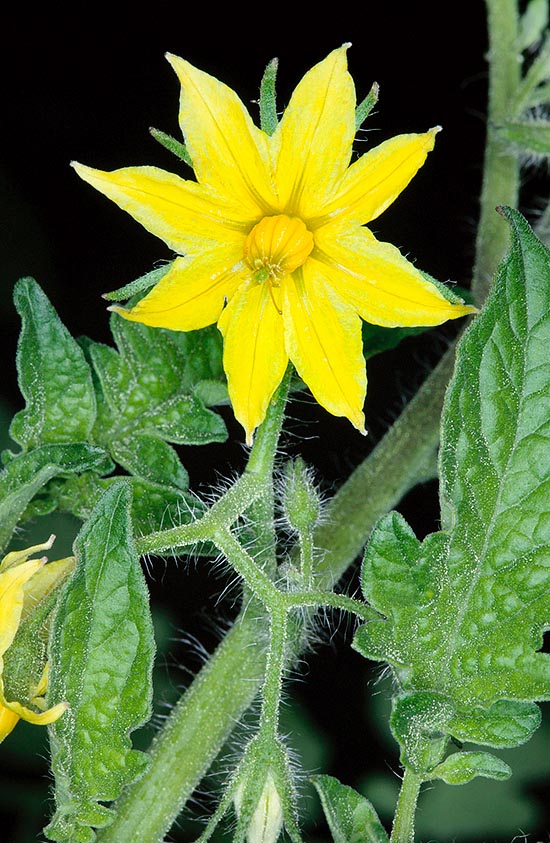
Solanum lycopersicum flower are bisexuate, actinomorphic, yellow and form in variable number, 3 to 20, on inflorescences usually produced at the leaves axil © Giuseppe Mazza
The tomato is the edible fruit-berry of the Solanum lycopersicum, South American native solanacea, nowadays cultivated, in countless varieties almost all over the world.
The alimentary use of the tomato, raw or prepared in several ways has rendered it a symbol of the Mediterranean feeding.
In almost all the languages are utilized names such as tomato-tomate coming from the Aztec term tomatl. Actually, the term tomatl referred to the tomatillo, a Physalis similar to the bladder cherry, and when the Aztecs began to cultivate the tomato coming from the Andes, bigger and redder, did call it xitomatl. The Spaniards exported in Europe the xitomatl calling it tomate.
The term pomodoro, that refers to the golden look of the fruit, was born in Italy and has been imported in few other languages, such as the Polish.
The scientific name Solanum comes from the Latin “solamen” = consolation, solace, because of the medicinal and sedative properties of some species of this genus; lycopersicum from the Greek λυκος (lycos) = wolf and “persicon” from the Latin term “persica malus” = apple from Persia, that indicated the fruit of the peach tree, therefore wolves’ peach, in reference to the toxic properties that in the past were attributed to the tomato, actually present only in the green parts of the plant.
Due to the existence of many varieties the botanical description is necessarily generic.
The tomato is an herbaceous plant, usually annual, 50 cm to 2 metres tall, initially erect but tending to become procumbent especially because of the weight of the fruits.
The stem and the leaves are pubescent due to the presence of glandular hairs and are characterized by a characteristic pleasant smell.
The leaves are large (10-25 cm), formed by unequal leaflets with more or less engraved margin.
In some varieties the stem has indeterminate development, producing for the whole life a growing apical meristem, with production of new leaves and inflorescences. In other varieties, the apical bud transforms in inflorescence and the plant gets bushy look and contained size. The indeterminate development varieties in the tropical climates may be perennial, whilst in the temperate ones they die annually. The determinate development varieties are always annual. The root is tapering and ramifies producing a dense rooting apparatus.
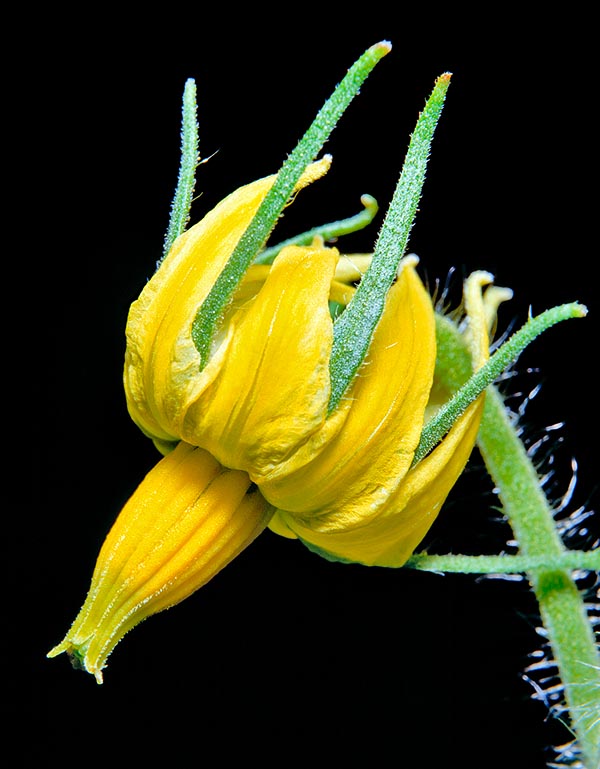
The anthers are merged to form a columnar sleeve surrounding the pistil © Giuseppe Mazza
In the cultivated varieties the flowers are usually self-pollinating, with the pollen transferring from the anthers to the stigma of the same flower. The crossed pollination takes place only occasionally. When this happens, the pollinator is an insect, usually a bumblebee.
The fruit is a berry of variable shape and size depending on the variety and of the cultivation conditions, of red colour when ripe due to the presence of carotenoid pigments.
Inside the fruit a series of cells, different in number depending on the varieties, contains numerous discoidal seeds.
The denomination Solanum lycopersicum was attributed by Linnaeus (1753), later on Miller proposed another genus, different from Solanum, classifying the plant as Lycopersicon esculentum, name that was then accepted for long time, as an alternative to Lycopersicon lycopersicum.
More recently, the studies of genetics have led to insert again the tomato in the genus Solanum, restoring the name of Solanum lycopersicum nowadays generally accepted even if not unanimously.
To the genus Solanum, group lycopersicum are presently ascribed other 12 species of wild tomatoes, some of them completely intercrossable with the tomato.
History
It is thought that the cultivation of the tomato has developped in South America, between Peru and Ecuador. Rightly in these areas still now grow the wild species that are deemed having originated the cultivated tomato, in particular the Solanum pimpinellifolium.
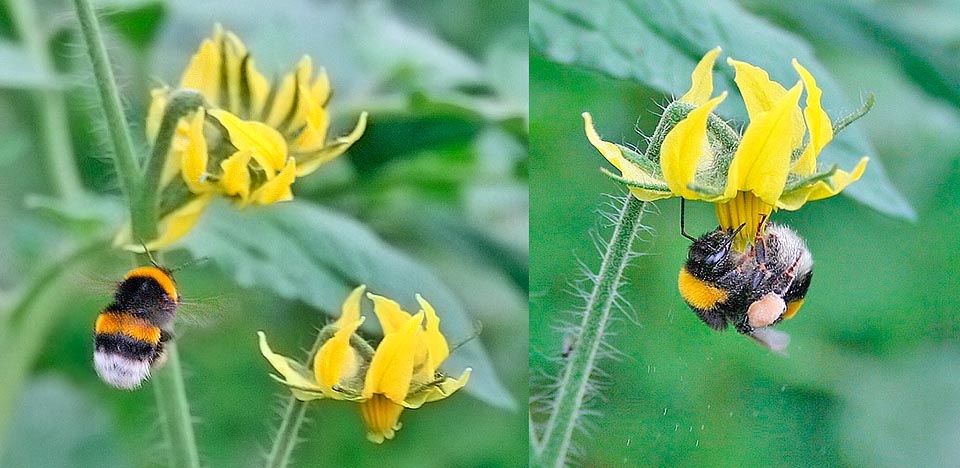
In the cultivated varieties the flowers are usually sefpollinating, with the pollen moving from the anthers to the stigma of same flower. Crossed pollination is a quite rare fact. When it occurs the pollinator is an insect, often a bumblebee, at times introduced in the greenhouses to increase production © Le Tomatologue
The Mesoamerican populations consumed the tomato, in a variety characterized by small fruits, since remote times: already around the 500 BC it was cultivated in Mexico and nearby regions. Besides the food use, it was thought that the ingestion of the seeds would help the divinatory powers. The modern varieties of the tomato come probably from the original forms after mutations and selections.
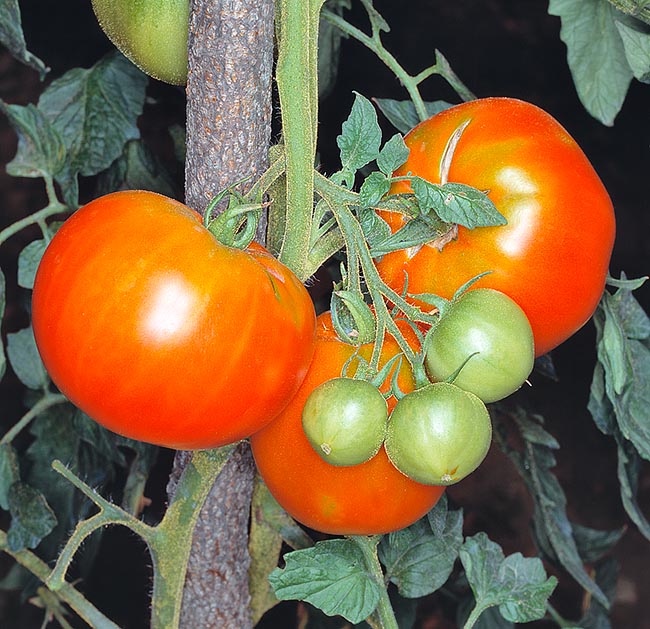
Pinnatisect leaves. The fruit is a variable in shape and size berry depending on variety and culture conditions, naturally red when ripe due to the presence of carotenoid pigments © Giuseppe Mazza
The tomato sauce was part of the Aztec cuisine.
The Spanish conquistadores accompanying Cortés did observe that the Aztecs ate a fruit they called xitomatl and the Franciscan Bernardino Sahagun wrote that the Aztecs mixed tomatoes and chili for preparing a sauce.
It seems that the introduction of the tomato in Spain is to be attributed to Hernan Cortés after the conquest of Tenochtitlan (Mexico City) even if some historicians suggest that already Christopher Columbus might have carried some specimens since 1493.
The tomato arrived first on Seville and from there reached Italy.
The first botanical description of the tomato is due to Mattioli, in a herbarium dated 1544, who describes it as a new variety of the eggplant introduced in Italy, christening later on as “mala aurea: pomo d’oro” and classifying it amongst the poisonous species, though referring news of its alimentary use, fried in oil.
In 1554, a Dutch herbalist, Dodoens, made a detailed description of it and the fruit earned the reputation of aphrodisiac. This reputation explains the terms “pomme d’amour” in French and “love apple” in English with wich the tomato is defined.
Actually, by mid ‘500, the tomato was consumed cooked, but, more often, only as ornament for the table. In fact, the taste of the tomato initially rejected many people and in a French text of ‘600 it is written that this plant was better than the taste and smell and that, if eaten, caused nausea and vomiting.
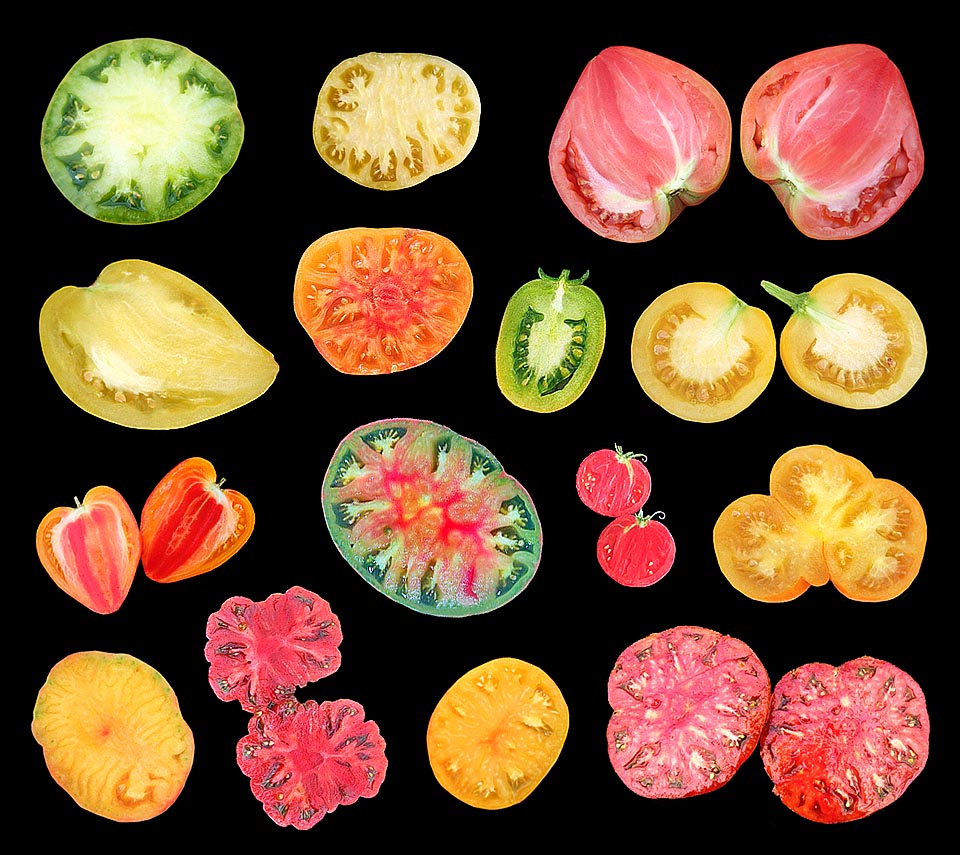
There are almost 15.000 varieties. Here some dissected fruits showing the biodiversity created by man © Le Tomatologue
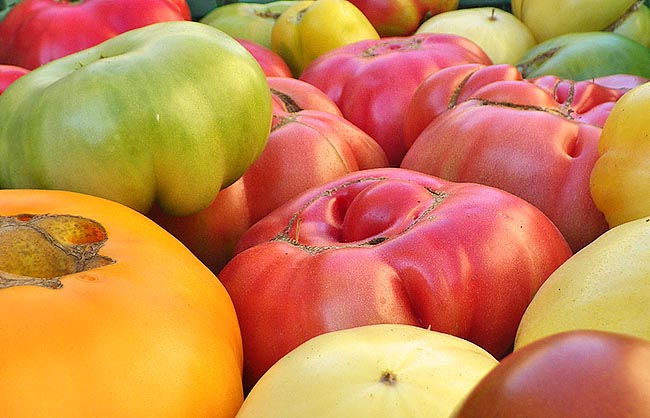
High calibre variety. Some like African Breed may exceed the kilogram © Le Tomatologue
In northern Europe, the cultivation of the tomato is documented by the end of the ‘500 in England, where however it was considered as not edible and poisonous. After the middle of the ‘700, anyway, the alimentary use had diffused also in England and in its American colonies.
In USA and in general in the Americas, from where it came, the affirmation of the tomato as edible vegetable found on the contrary many difficulties for the widespread popular belief of its toxic powers. An important incentive to the alimentary use came from Thomas Jefferson who had appreciated them during his stays in France.
In order to advertise the use of the tomato and to show the absence of toxicity, in 1820 the American colonel Robert Gibbon Johnson publicly ate a tomato in front of an incredulous crowd. It is said also that they have tried to poison Lincoln administering him some tomatoes. The president did not die poisoned and, conversely, became a tomatoes consumer.
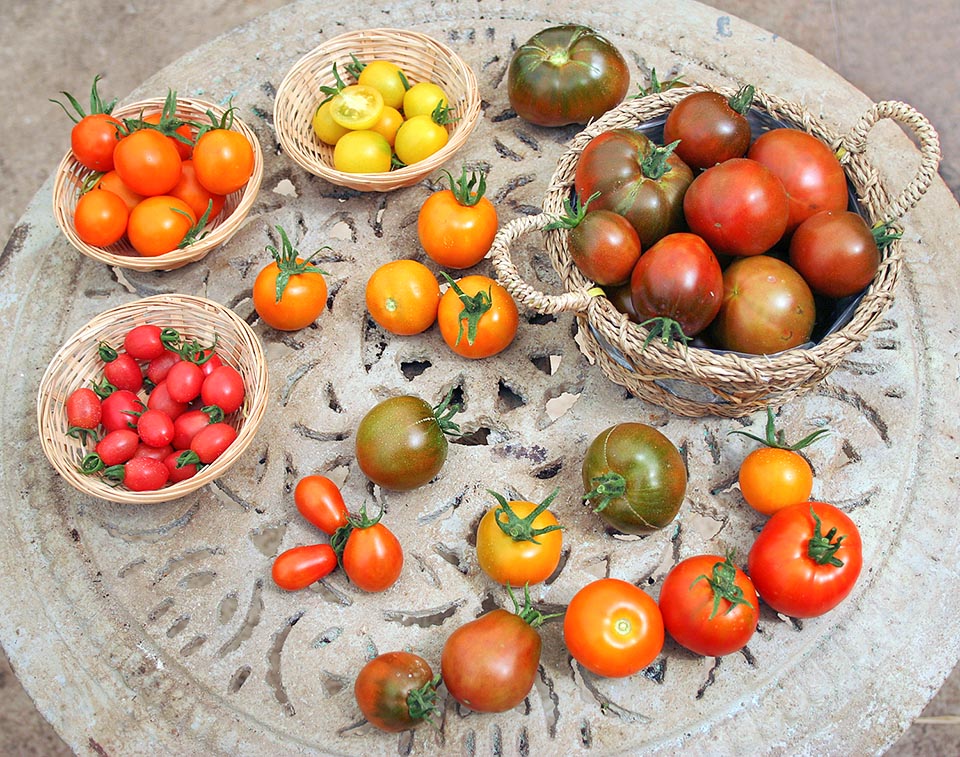
Small and medium calibre varieties stock © Le Tomatologue
The tomato in the cooking recipes
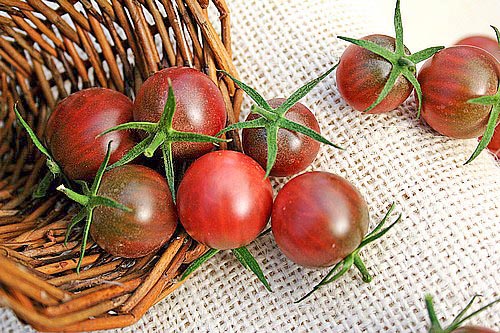
Black Cherry: bunches with 10-12 very sweet 20-25 g fruits © Le Tomatologue
It’s starting from the 18th century that the tomato is gradually utilized as cuisine ingredient. The oldest Neapolitan recipe that we know is the “ Spanish style tomato sauce” and dates back to 1692.
In 1839, the Neapolitan don Ippolito Cavalcanti, duke of Buonvicino, in his “Home cooking with the Neapolitan language”, in the appendix to the “Theoretical practical cuisine”, gives the recipe for his “Sauce of ripe tomatoes” to be used to flavour the vermicelli but also other foods.
“Buy four “rotoli” of tomatoes, cut them, take off the seeds and that water…” after having cooked and sieved “consume it on the fire putting there a third of flare fat, when the sauce has well consumed cook twelve “rotoli” of green vermicelli, and well drained mix them into that sauce” seasoned with salt and pepper are then sautéed on the fire to absorb well the sauce. It is suggested also to put the sauce also “on the meat, on the chicken, on the fish, on the eggs”. One “rotolo” (divided in 1000 “trappesi”) was a unit current in the Kingdom of Naples and did correspond to about 891 grams.
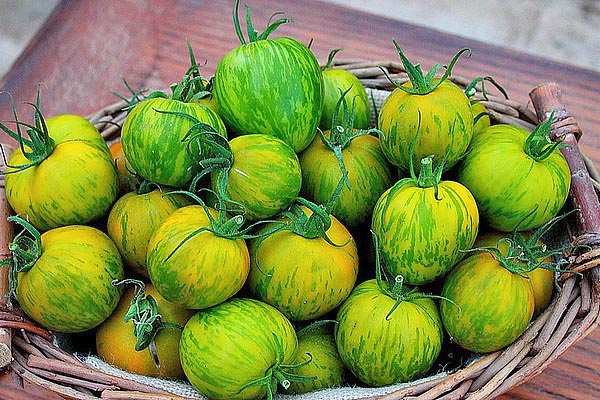
Green Zebra: 5-7 60-120 g and 5-7 cm fruits bunches. Firm not sour pulp © Le Tomatologue
In the same time appear news of pasta with tomato and pizza with tomato. The classical recipe of the macaroni with tomato and Parmesan is documented much more recently and in 1913 the agronomist Antonio Bizozzero writes: “be sure that the macaroni with tomato, with relevant seasoning of pure cream butter and very old Parmesan cheese, will become world institutions”. During the second half of the ‘800 an enquiry informs that the consumption of tomato is very diffused in southern Italy and in particular in the Naples region, where it is the most utilized favouring form the macaroni and with them the most common aliment. The caloric intake of the tomato is almost insignificant and it is the only great use culture in the world that has no precise dietary rôle. To its success contributed the easy storability of its derivatives.
The conservation of the tomato
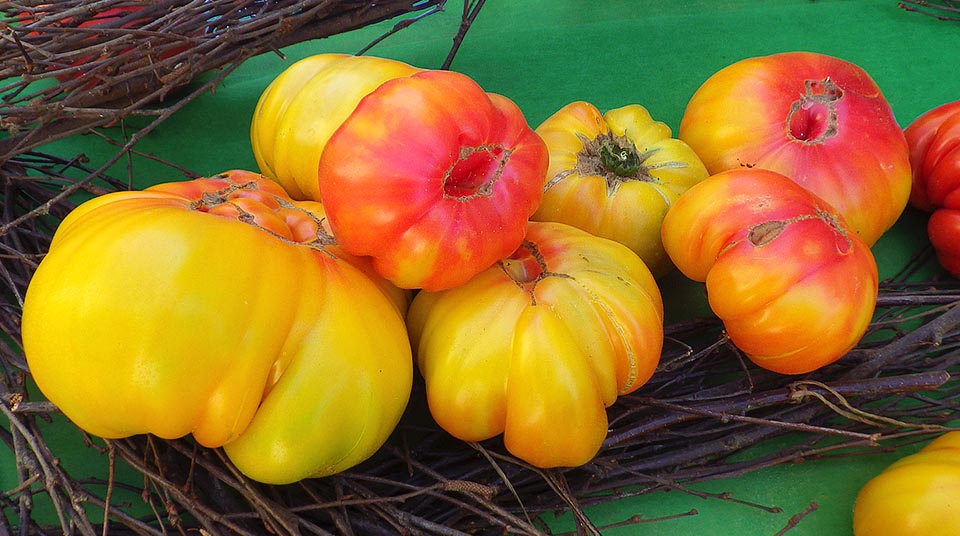
Peppermint, with 250-350 g fruits. It's an old variety turning yellow native to Tennessee © Le Tomatologue
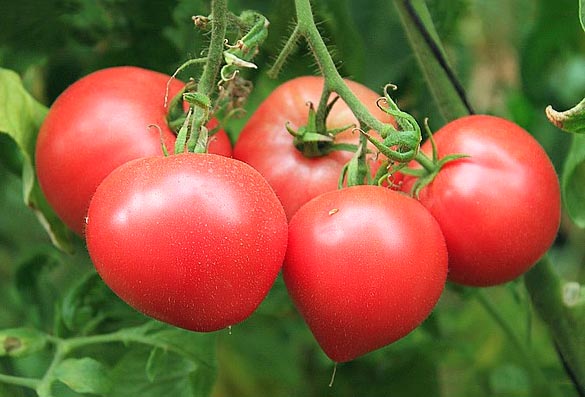
Faworit: medium size variety of Polish origin. Firm pulp. Ideal for stuffing © Le Tomatologue
At the same time, first in Piemonte and then in Naples, Francesco Cirio will enter the production of tomato preserves, specializing later on in the production of peeled tomatoes, produced starting from the typical Campanian tomato, the San Marzano.
The production of the tomato
Presently the main producers of tomatoes in the world are China and India, Italy being the first European producer.
The total annual production is of more than 150 million of tons, in some thousands of different varieties.
Some varieties produce small sized fruits, less than one centimetre, whilst other ones produce fruits much more over the 10 centimetre with a record of weight over the 3 kg; the colour varies from red to yellow to purple up almost to blue almost black due to the presence of anthocyanins. Despite being the Italian tomatoes among the best in terms of taste and scent, the organoleptic qualities of the tomatoes currently on the market are much lower than those present in a recent past.
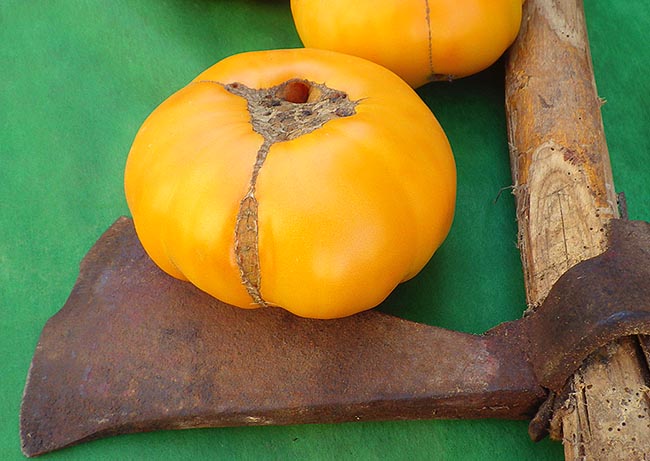
Nelson's Golden Giant: showy pulpy 180-500 g fruit © Le Tomatologue
This characteristic, nowadays introduced in most of the commercial varieties, is due to the inactivation of a gene that is involved in the production of sugars and flavours: in this way they have obtained tomatoes with appealing appearance but poor of taste.
In Italy, the tomato is cultivated in all regions, being Sicily and Calabria the main producers.
Usually, the tomato is sown in seedbeds and later on transferred in the ground, even if in the industrial cultivations they prefer the direct seeding in the field. It loves averagely sunny soils and requires a moderate irrigation.
In the cultivation in full field it is practiced the alternation with other cultures, not solanaceans, in order to avoid an excessive growth of specific parasites. Some varieties, especially those for the fresh consumption require the positioning of supports, reeds for instance, whilst other varieties do not require them. For some varieties is applied the “disbudding”, that is the removal of the axillar gems to reduce the vegetative development and strenghten the fruit production.
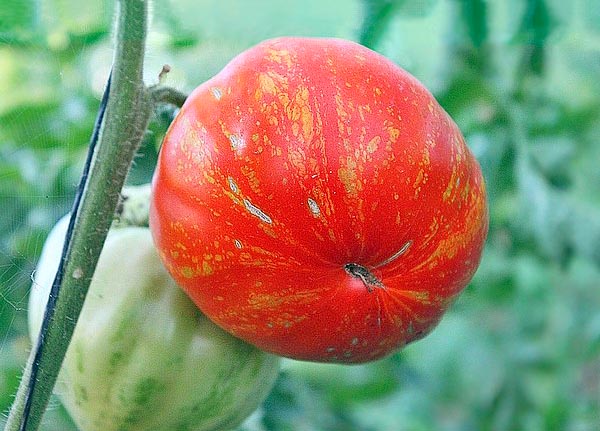
Marmande de Montpellier comes from crossing Marmande Garnier, wrom which come the taste and the firmpulp, and Feuerwerk from which come the attracting tigre look. Can reach 800 g © Le Tomatologue
Adversities and parasites
Alterations may take place in the development or in the ripening due to water imbalances, such as the apical rottenness of the fruits or the splitting of them.
Among the parasites we recall fungi that attack the roots and the collar such as Fusarium oxysporum and Vertillium dahliae, Rhizoctonia solani, Botrytis cinerea and Pythium.
Other parasites attack the aerial part, such as the Late blight (Phytophtora infestans) that attacks the leaves, the stem and the fruits or the Early blight (Alternaria solani) that forms necrotic spots and lesions and chokings of the collar. We recall also the Anthracnose (Colletotrichum coccodes), the Botrytis (Botrytis cinerea). Among the animal parasites are te be recalled the larvae of the noctuids and of the elaterids besides the aphids (Myzus persicare) and the Red spider mite (Tetranychus urticae). Dangerous are also some nematodes. Among the viroses we recall the tobacco mosaic virus.
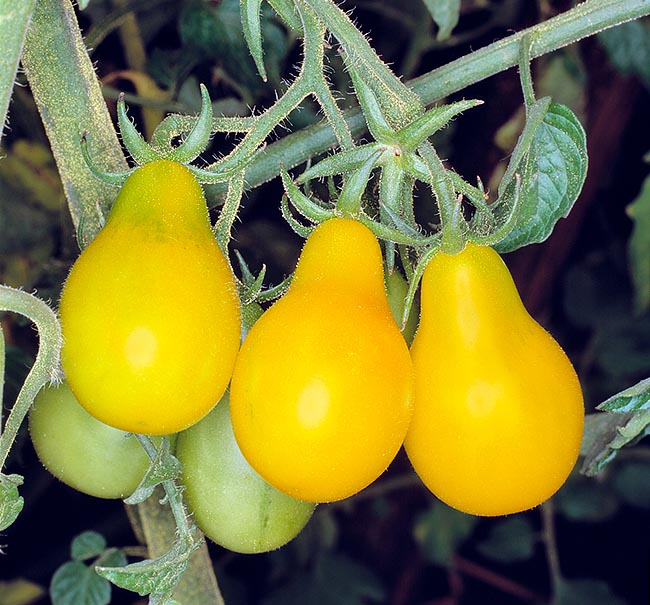
The variety Poire Jaune produces many poorly sour fruits © Giuseppe Mazza
The leaves, the stems and the green unripe fruits contain small quantities of the toxic alkaloid tomatine, besides the solanine. Though the concentrations are very low, lethal intoxications have occurred after the use of infusions of tomato leaves or of salads of green leaves.
Salmonellosis
Cases of salmonellosis have occurred due to the consumption of infected tomatoes.
In USA in 2006 have occurred 172 cases of infection attributed to the tomato and in 2008 after other cases of salmonellosis some lots of tomatoes have been confiscated.
Positive effects on health
The regular consumption of tomato has been associated to a decrease in the risk of chronic degenerative diseases and of some tumors. Since time some epidemiological studies seem to confirm these observations in particular a reduction in the risk of cancer to the prostate and suggest that the effects may be linked to the presence of various antioxidant substances such as the carotenoids, in particular the lycopene, the abscorbic acid, the vitamin E and various flavonoids.
Studies of bioavailability of the carotenoids and of the lycopene in particular, that is of the concentrations of these substances in the blood after a meal, have proved that the association of the raw tomato with a dressing made with olive oil guarantees a high input of these antooxidants.
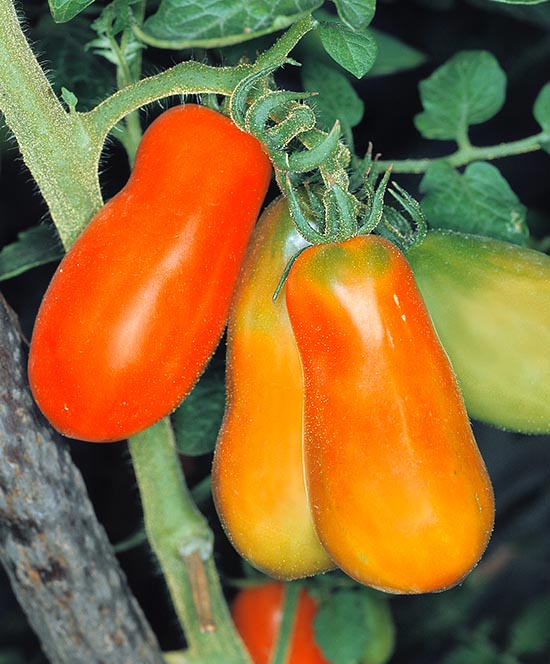
Yellow Pears are usually excellent for sauces, preserved and stuffed © Giuseppe Mazza
Another potentially important substance present in the tomato is the kaempferol, holding antioxidant and antinflammatory properties that have proved useful, at least in the laboratory animals, in various pathologies such as diabetes and asthma and in the attenuation of cancerous substances. Some students suggest that the association of this substance with the traditional chemotherapeutics is in condition of increasing the effectiveness of the therapy and reducing the side effects.
The cooking of the tomatoes and also the transformation in canned products, along with the association with olive oil, greatly increase the assimilation of the lycopene. Consequently, the use of tomato sauces or of pizza with tomato results as particularly positive.
It appears that the lycopene can act as antioxidant and as regulator of the cellular proliferation. Even if the biological effects of the lycopene can be important, it is not to be forgotten that the tomato is an excellent source of important nutrients, such as the folate, the vitamin C, carotenoids, polyphenols, all substances having potential anticancer effects, not forgetting the richness in potassium and in the vitamins A and E.
Recently, has been done an extensive review of epidemiological studies on the effects of a diet rich of tomatoes of aliments rich of lycopene that seem to confirm the absence of negative effects on the health and, conversely, the presence of a capacity of reducing the risk of prostate, lungs and stomach cancers and, even if with minor significativity, of pancreas, colon and rectum and uterus cancers. These data in any case require further confirmations, as also it is not sure that the effects are due to the lycopene or to other substances, seen that the tomato is rich of other antioxidant substances or anyway capable to reduce the levels of potentially cancerous free radicals. Although if are missing extensive epidemiological studies that may confirm definitively these data also on the man, it is considered reasonable to suggest the consumption of about one portion per day based on tomato as a general strategy to reduce the risks of prostate cancer as well as of other tumors or degenerative diseases.
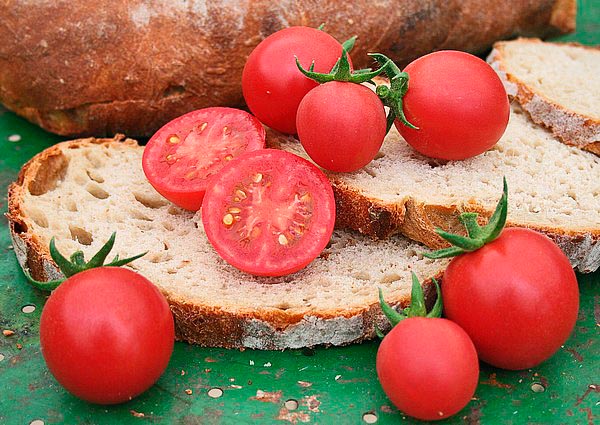
The Cherry varieties are ideal for appetizers, even offhand with bread © Le Tomatologue
The epidemiological studies during the second half of the twentieth centry seem to confirm that the populations living in the Mediterranean basin enjoy of a health condition characterized by reduction of the degenerative diseases in respect to other populations. The data show that the recourse to the so called “Mediterranean diet” characterized by high consumption of fibres, fish, fruits and vegetables and olive oil leads to a reduction of the risk of cancer and of cardiovascular diseases.
It is thought that this positive effect is due, at least partially, to the abundance of antioxidant substances in these aliments, in particular in the olive oil and in some vegetables among which the tomato. Another compound potentially beneficial present in the Mediterranean diet is the resveratrol, present in some aliments among which the red wine. To this substance have been attributed antitumor and antinflammatory actions.
Genetically modified tomatoes (OGM)
The first genetically modified tomato for which was authorized the human consumption in USA in 1994 was the FlavrSavr. A gene inserted in these plants interferred with the production of an enzyme, the polygalacturonase, involved in the softening of the tomato.
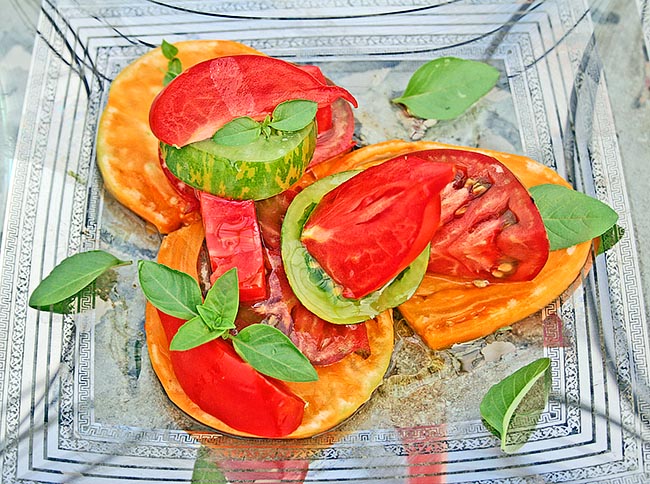
Healthy salad of tomato and basil in merry coloured scheme © Le Tomatologue
Other types of OGM tomato have been produced with the same aim (to delay the ripening of the fruit and so to have a ripe fruit remaining firm longer after collection), as well as a tomato resistant to the insects attack. But also these ones have not met a commercial success.
More recently they have produced OGM tomatoes with high nutritional value that are still in the experimental phaes, as well as tomatoes resistant to the ambiental stress. Further attempts were focused on the production of tomatoes, with better taste, obtaining a product that encountered the preference of the 60% of the persons that have tasted them, but it has come that they did contain very low quantities of lycopene.
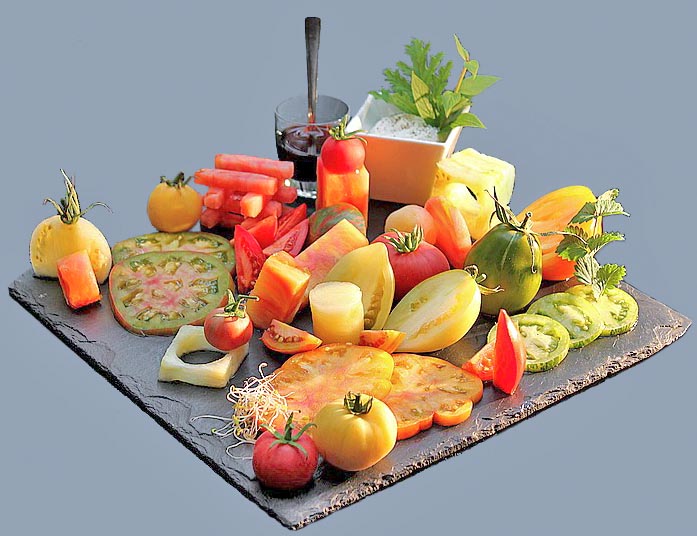
Besides good, tomato is the base of Mediterranean diet and has sure medicinal properties due to presence of various antioxidant substances like carotenoids, lycopene in particular, ascorbic acid, vitamin E plus serveral flavonoids © Le Tomatologue
We have also to make present that the genetic manipulation of the tomato is amply utilized as instrument for the study of the genetic mechanisms of base and of the vegetal physiology.
Tomato genome sequencing
In 2012 they have sequenced the complete genome of one of the varieties of tomato. It is possible that this acquisition will be able to help in an important way to the research on this species.
Synonyms: Solanum lycopersicum var. Lycopersicum ; Solanum pomiferum Cav. (1802).
→ To appreciate the biodiversity within the SOLANACEAE family please click here.
